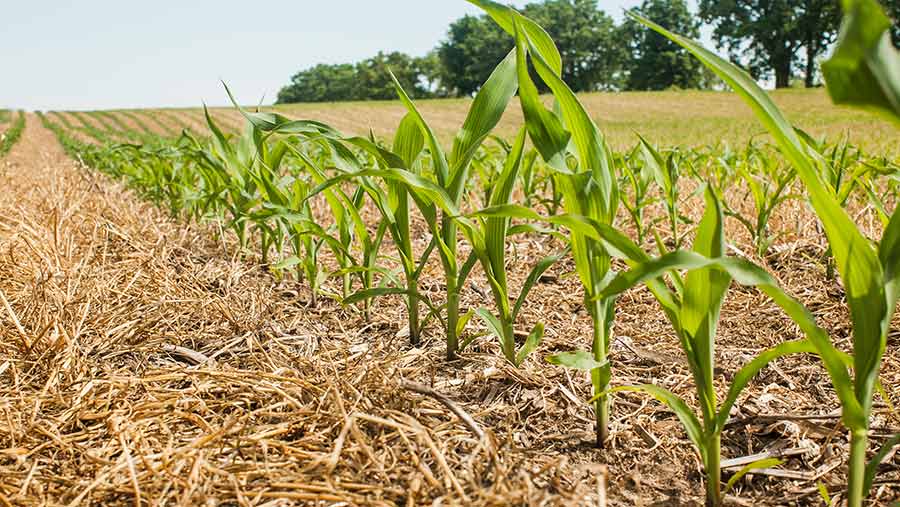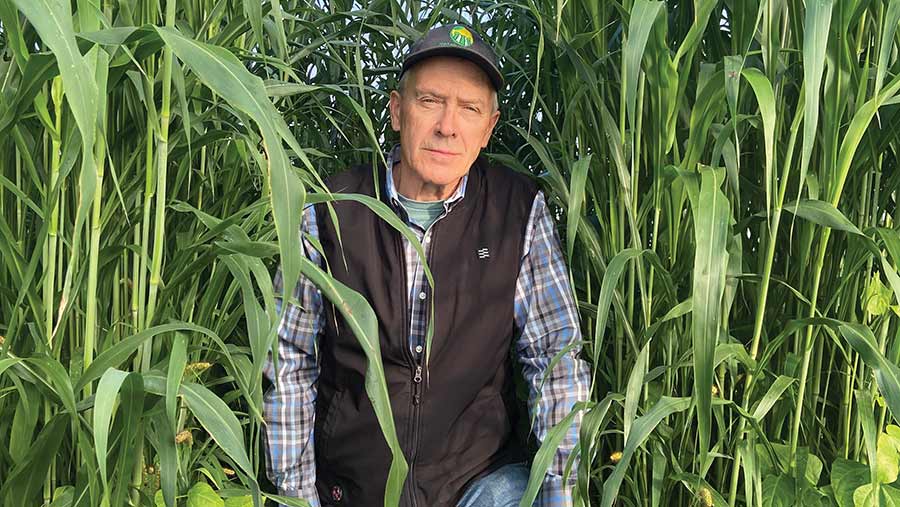International expert’s tips on ramping up soil carbon levels
 © Adobe Stock
© Adobe Stock Soil carbon levels can be moved in the right direction by applying a set of five soil health principles and recognising that every green plant is a carbon inlet, according to US-based international soils expert Jay Fuhrer.
Putting carbon back into soil helps with its ability to cope with future climate challenges by improving its resilience, he says, with carbon being the “food” that powers soil biology and makes soil function occur.
Jay stresses that soil carbon influences soil properties – giving soil a more stable structure, helping with water retention and infiltration, making it less prone to erosion, increasing biological activity and improving its nutrient supply characteristics.
See also: SFI 2023: Tips on making it work on your arable farm
“That’s why farmers who increase soil organic carbon see better soil health follow.
“They do that by adopting a systems approach that embraces the principles around reduced soil disturbance, the use of covers, crop diversity and livestock integration,” he says.

© Jay Fuhrer
Old sunshine
Jay points out that soil organic matter was built in the past through “old sunshine” by having abundant plant diversity with numerous species and large populations of herbivores.
“Our ancestors had a circular type of agriculture, in which everything was recycled.”
Having so many species growing meant that the soils used to get root exudates from a diversity of plants, which fed the soil microbes and resulted in soil aggregates being built.
Five soil health principles
Jay Fuhrer emphasises that these are principles, not practices, for a systems approach.
As every farm is unique, growers should make each principle work for their situation, rather than being tied to a set formula.
- Provide soil armour/cover
- Minimise soil disturbance
- Include plant diversity
- Maintain living roots/plants
- Integrate livestock
All five working together can help to restore a landscape, he stresses.
In contrast, today’s linear cropping systems based on monocultures can’t build soils in the same way, as the soil biology receives exudates from just one annual plant at a time, he adds.
“Soil carbon has been lost by agricultural systems which took this species complexity away in the drive to become more efficient.
“To this end, agriculture has become an extraction or export business. Carbon leaves the field in the grain, so unless you are taking action to slow these losses and put carbon back into the ground, you are going to keep on degrading your soils.”
New sunshine
Jay says that farmers can use “new sunshine” to drive biological carbon capture, by harnessing plant diversity and using animals to do some of the decomposition or recycling required.
Carbon enters the soil as living, dead and decaying material and the “easy come, easy go” nature of soil carbon means that farmers need to appreciate the role played by plants and the importance of cover crops, he adds.
“The exudates they give off are consumed by soil microbes, which build aggregates and make the glue that helps to limit soil erosion and get water and oxygen into the soil.”
Put into a system, they mimic those original scenarios from years ago, eventually helping to restore landscapes and build back what’s been lost. “Accept that you need to build aggregates for the rest of your farming career.”
He likens the process to accelerating biological time – in that it shortens the window in which change can take place. “Multispecies cover crops make something happen in a shorter time period than if there had been monocultures there.”
What about no-till and soil health?
No-till on its own is not enough to halt soil degradation as it doesn’t put carbon back into the soil.
“It slows the loss of soil carbon, which is a good thing,” explains Jay. “But you need to combine it with a green plant or cover to put the carbon back.
The role of plants: Compounds in plant root exudates
- Carbohydrates – primary source of energy
- Amino acids – easily absorbable form of nitrogen, helps photosynthesis
- Organic acids – cellular metabolism, mineral acquisition, toxic metal tolerance
- Flavonols – bring colour and flavour
- Lignins – adds strength and stiffness to cell wall
- Coumarins – pleasant, sweet odour
- Aurones – anti-fungal
- Glucosinolates – plant defence against pests and diseases
- Anthocyanins – pollinator attractant, UV-light protection
- Indole – regulates bacterial physiology
- Fatty acids – energy source in plants
- Sterols – regulate growth and development, stress resistance
- Allomones – predator defence
- Proteins and enzymes – nutrient cycling, biocatalysis
“That’s why cover crops are so important. Plants are microbial and cover crops make endophytes available for the next crop. Every green plant is a carbon inlet.
“What you’re aiming for is minimum carbon loss and maximum carbon input.”
Why do you need livestock?
Livestock play an integral role by taking high carbon materials and converting them to low carbon, through rotational grazing.
“Ruminants do some of the decomposition or recycling required,” explains Jay. “Without them, a high carbon crop takes longer to decompose.”
Where grazing is managed, the top of the cover crop is grazed, while the lower part is trampled. “That helps to both feed the ruminant and feed the soil.”
Livestock also do much better where there is greater plant diversity and where perennials are being used in the system, he adds.
Results from Menoken Farm
Long-term monitoring undertaken at Menoken Farm in North Dakota, where Jay Fuhrer is based, has looked at changes in soil organic matter levels and soil biology.
The farm was established in 2009 as a conservation demonstration site, with the aim of improving soil health through innovation and education.
Consisting of 10 fields, it has been investigating cover crop combinations and how they can be applied, as a form of rebuilding the landscape.
Soil organic matter levels rose by almost 2% over 10 years where the most crop diversity, cover crops and livestock integration were in place, going from just over 3% to more than 5%.
Soil biology was greatest in native rangeland, which has never received any pesticide, but was also high in a rotational perennials system.
Cropped land, with cover crops and allowing the use of herbicides, had less biomass and fewer soil microbes, despite improvements made and the right direction of travel.
“It’s a building-back process, but you have to do more than just build back the soil. Diversity is the driver,” says Jay.
Who is Jay Fuhrer?
Growing up on a mixed farm in central Dakota, Jay Fuhrer went on to work for the US Department of Agriculture for 40 years.
Today, he is based just east of Bismarck in North Dakota at Menoken Farm, a demonstration and educational farm that carries out long-term monitoring work on soil health.
Considered to be a founder of the soil health movement and responsible for the shift from treating symptoms to addressing the causes, he mentored Gabe Brown (author of Dirt to Soil) for many years.
Jay Fuhrer was speaking at the two-day Base-UK conference held in Nottingham in early February.

